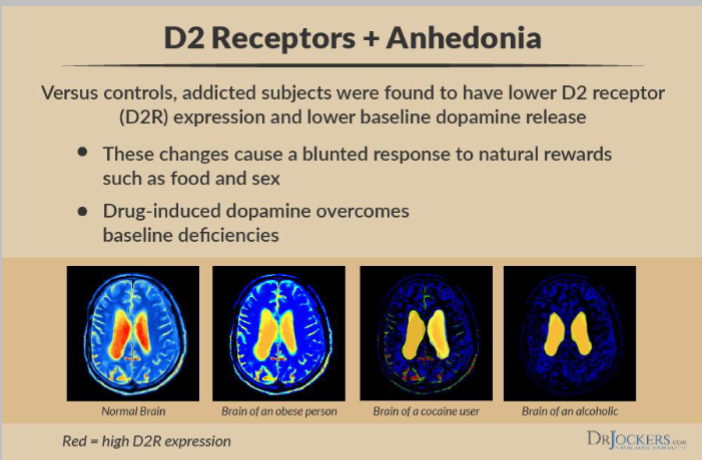Limbic System and Addiction
1/28
There's no tags or description
Looks like no tags are added yet.
Name | Mastery | Learn | Test | Matching | Spaced |
|---|
No study sessions yet.
29 Terms
What is the difference between pyramidal and extrapyramidal motor pathways?
How do they have to do with emotion
Pyramidal - Controls Voluntary Movements
Extrapyramidal - Modulates and Regulates movements
They have significance with the ability to smile.
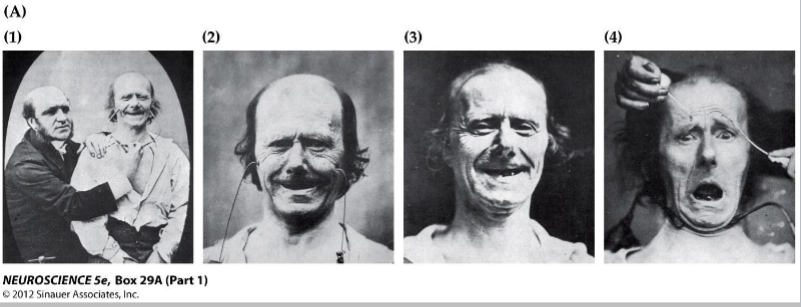
What is the difference between voluntary and involuntary smiles, and how are they affected by pyramidal/extrapyramidal motor pathways?
French neurologist/physiologist Duchenne (1860’s)
• Happiness produces a “Duchenne Smile” (a true emotional smile)
which cannot be “faked”, can’t be voluntarily produced
• Some muscle groups are “put into play by the sweet emotions of the soul”
Involuntary
Medial Forebrain and Hypothalamus
Extrapyramidal
Cranial Nerve 7
Voluntary
motor cortex and brainstem
pyramidal and extrapyramidal
Cranial Nerve 7
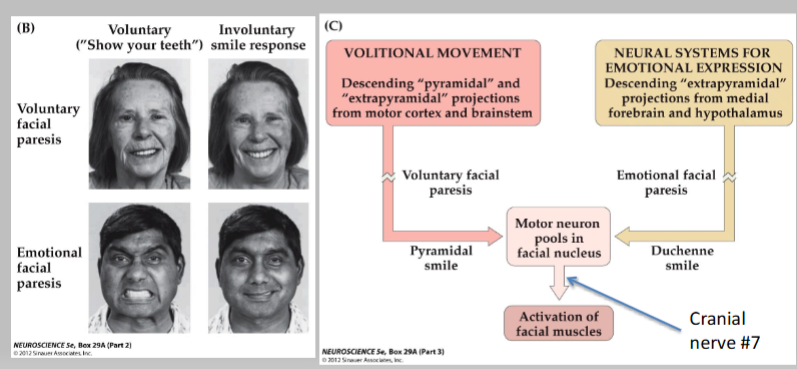
What is the Papez Circuit?
Proposed circuit for emotional processing
• The “Limbic Lobe” (forms a rim, “limbus”, around corpus callosum and diencephalon)
• Main pathways to and through the hypothalamus
• Consists of Cingulate cortex, fornix, thalamus, mammillary bodies, hippocampus
• Missing amygdala, frontal cortex (emotional centers)
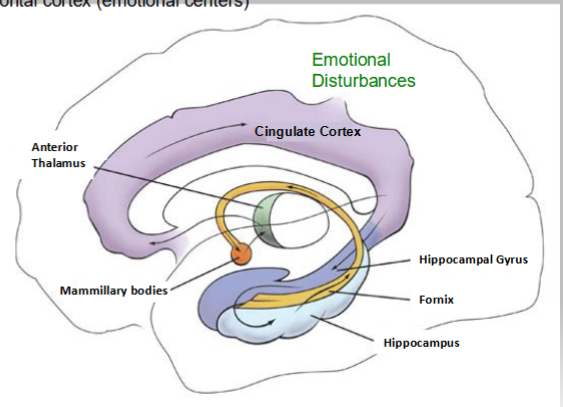
What is meant by the classic hypothalamus?
• Neuroendocrine function through connections with the pituitary gland
• Sleep/wake circadian rhythms
• Feeding and breeding (parasympathetic system)
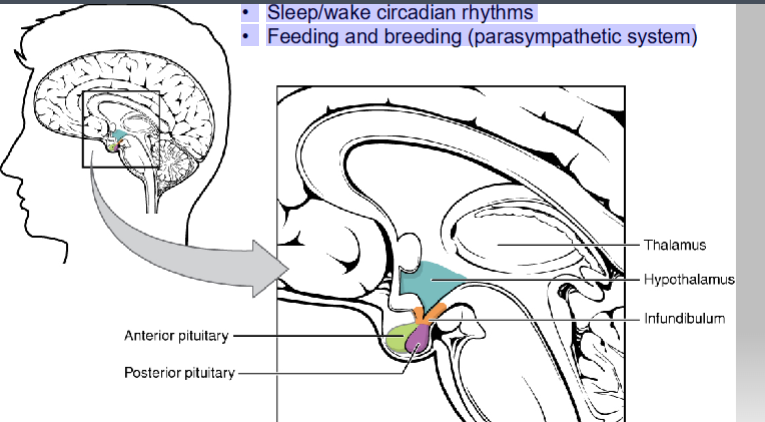
What is meant by the emotional hypothalamus?
• Autonomic expression of ____through ____ of the ____ system
• Expression of ____ and ____ ____ behaviors
Specific changes in ___ ___, _______, and ______ depending on the situation
• Autonomic expression of emotions through activation of the sympathetic system
• Expression of innate and conditioned defensive behaviors
Specific changes in heart rate, temperature, and sweating depending on the situation
The hypothalamus coordinates the ____ and ____ motor components of emotional behaviors. How was this information found?
visceral
somatic
• “Sham rage” – Philip Bard experiments in the
1920’s
– Removed both cerebral hemispheres,
underlying white matter and the basal
ganglia
– After anesthesia wore off, the animals acted
“enraged.”
• Autonomic correlates: increased blood
pressure & heart rate, dilation of pupils,
piloerection
• Somatic components: arching the back,
extending claws, snarling / hissing
– Occurred spontaneously without any
obvious target, therefore called “sham” rage.
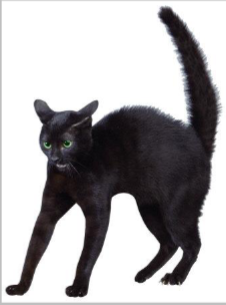
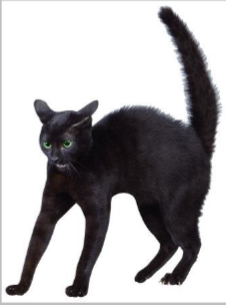
Hypothalamus is ____ and ______ for the coordinated rage response.
Hypothalamus is necessary and sufficient for the coordinated rage response.
Necessary = without the
hypothalamus, no rage response
Sufficient = with the hypothalamus, but no
cortex, there is a coordinated rage response
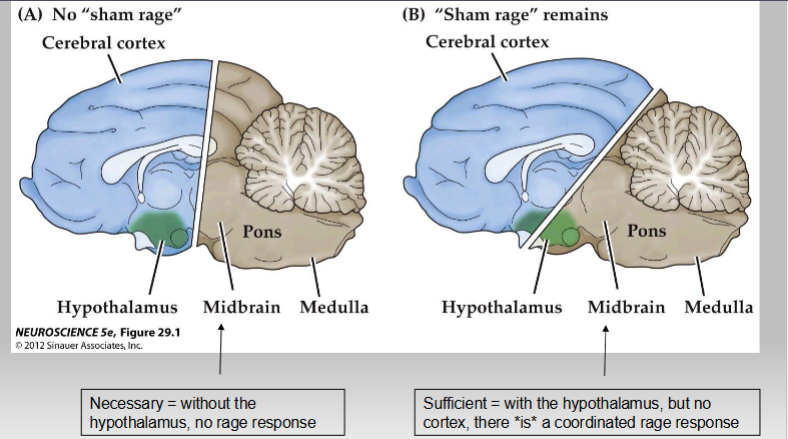
What is the amygdala?
Amygdala: missing piece of the emotional puzzle (for papez)
• Found in the temporal lobe –
adjacent to hippocampus
• Responsible for relating
sensory stimuli with emotional
experience
• Site of associative learning
• Connections with cortex,
hippocampus, hypothalamus,
thalamus, basal ganglia
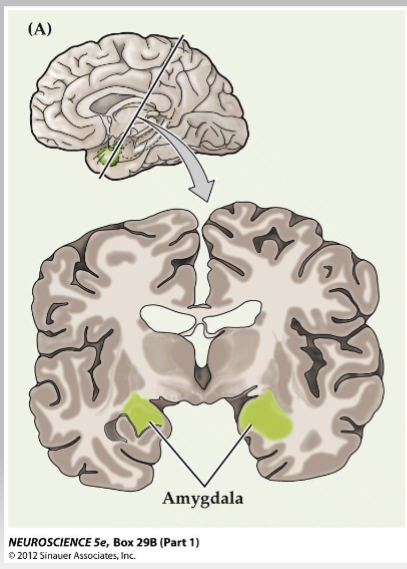
Papez+Amygdala
Connectivity between Amygdala and higher order cortical areas are required for
higher order processing of emotion and ultimately behavior
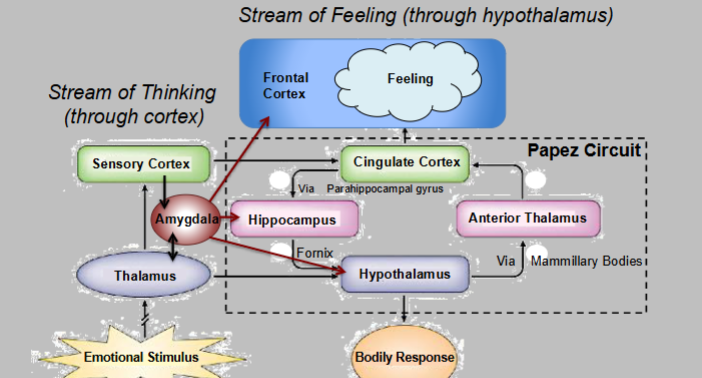
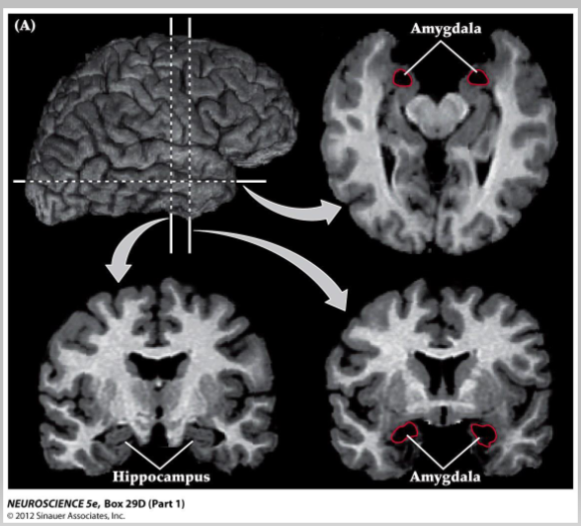
The Amygdala and Fear: Patient SM
• Patient “S.M.”; Urbach-Wiethe disease, destroyed ____ bilaterally
• Physically unable to feel ___- will approach ____ and ____
• Cannot recognize ___ in ___ expressions
• Does not have a concept of ____ ___
• Does have ___ response that does not depend on the ____
• Can follow group ___ responses due to ___ and ___ responses in others
• Has survived ___ abuse and had a ___ held to her throat
• Patient “S.M.”; Urbach-Wiethe disease, destroyed amygdala bilaterally
• Physically unable to feel fear- will approach spiders and snakes
• Cannot recognize fear in facial expressions
• Does not have a concept of personal space
• Does have startle response that does not depend on the amygdala
• Can follow group fear responses due to voices and body responses in others
• Has survived physical abuse and had a knife held to her throat
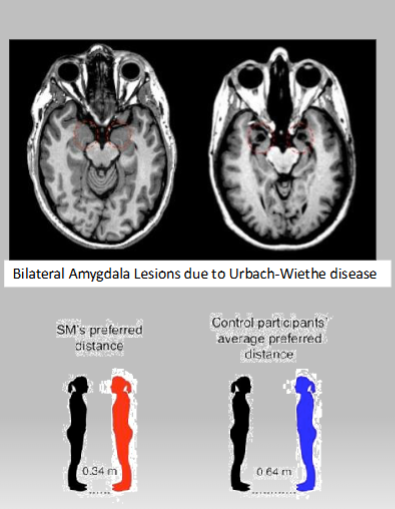
How do stimuli/events attain emotional significance
• Some ____ responses are ____, ____
– e.g., even lab rats display fear when exposed to fox odor
• Most _____ responses are ____ (_____); thus, they depend on _____
– _____learning: construction of _____ memories linking a ____ or ____ to an ____ body state
– can be ___, but often is ____
• Some emotional responses are automatic, INNATE
– e.g., even lab rats display fear when exposed to fox odor
• Most emotional responses are LEARNED (conditioned); thus, they depend on experience
– emotional learning: construction of implicit memories linking a situation or event to an emotional body state
– can be conscious, but often is subconscious
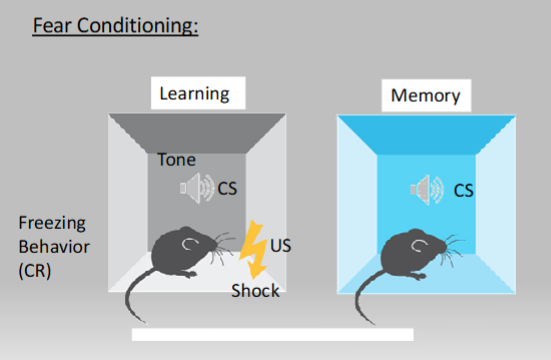
How is Fear Conditioning performed in mice?
• Innate reflex (conditioned response, CR) is modified by associating the normal trigger stimulus (unconditioned stimulus, US) with an unrelated stimulus (conditioned stimulus)
• An neutral auditory tone (CS) is paired with a shock (US)
• The experience of the shock is relayed by the somatosensory system as “pain”- negative reinforcement
• This association is “learned” by a strengthening of the auditory inputs through LTP
• This leads to better activation of amygdala circuits by the tone
• Enhances survival responses- freezing, changes in blood pressure etc.
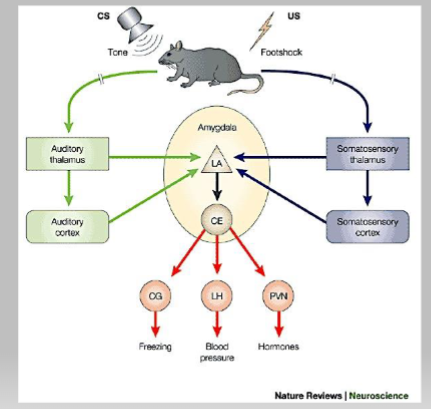
Fear conditions and memory require different ____ ____.
brain regions
Control individuals show appropriate fear responses to conditioned stimuli and no
deficit in a memory task
SM does not show appropriate fear responses to conditioned stimuli and no
deficit in a memory task
• Amygdala required for fear but not memory
WC shows appropriate fear responses to conditioned stimuli and but major deficit in a memory task
• Hippocampus not required for fear learning but required for memory
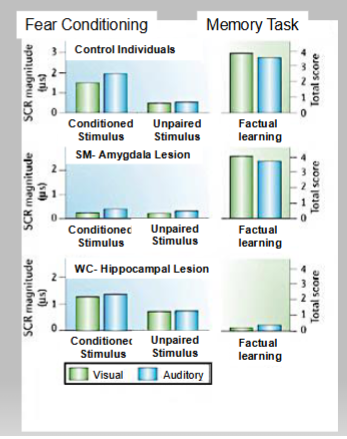
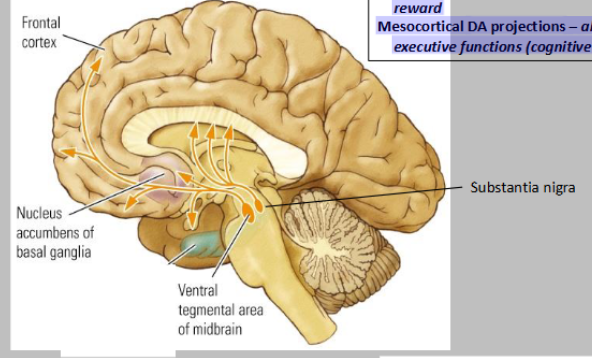
What are the three major Dopamine pathways
Nigrostriatal (dorsal striatum) DA projections - motor
Mesolimbic (ventral striatum) DA projections - reward
Mesocortical DA projections – alertness, executive functions (cognitive state)
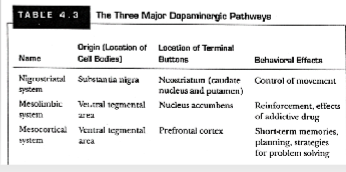
Emotions and “Motivation”
• Emotional processing by the “limbic system” guides ___ choices by signaling impending ___ and ___.
• ___(___) signaling in ___ ___(__ ___) important for ____of behavioral movements --- more DA signaling increases ____ to perform these behaviors again in the future.
• DA inputs to nucleus accumbens = emotional ___ circuit
• Emotional processing by the “limbic system” guides behavioral choices by signaling impending reward and punishment.
• Dopamine (DA) signaling in ventral striatum (nucleus accumbens) important for reinforcement of behavioral movements --- more DA signaling increases motivation
to perform these behaviors again in the future.
• DA inputs to nucleus accumbens = emotional REWARD circuit
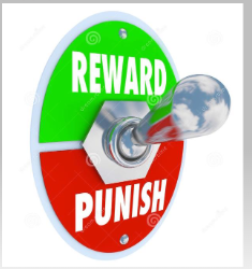
The Motivation Control (reward/reinforcement) system
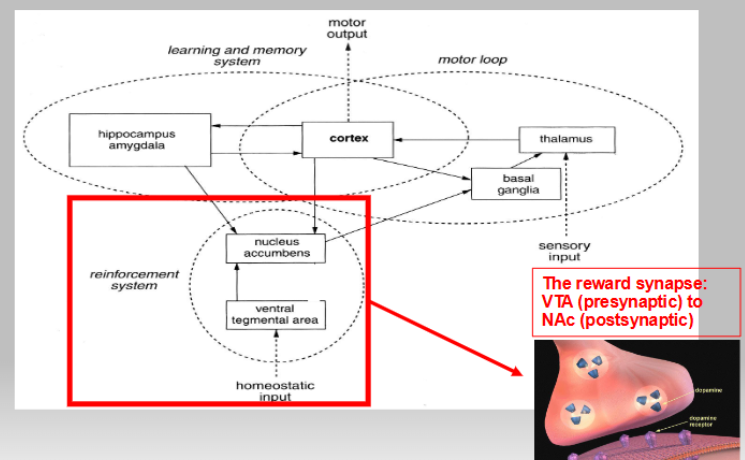
The reward system in our brain helps to promote our _____.
A ‘do-it-again’ synapse: even invertebrates have a rudimentary dopamine system!
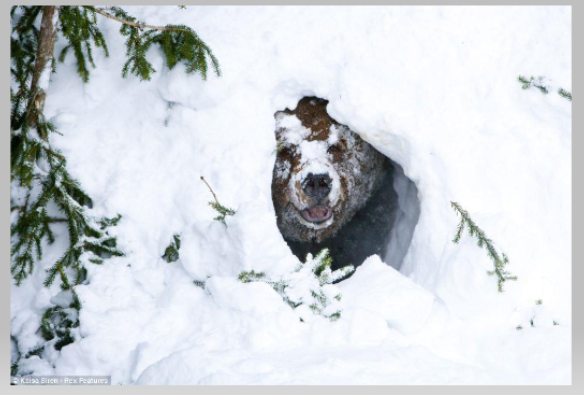
What are the five major brain regions involved in reinforcement and reward?
• ____ (____ ____ ____) - source of ____ cell bodies sending axon
____ to the ___ ___
• ___ ____- receives ____inputs (axon ____) from the
___
– all addictive drugs produce an increase of ____
• ____ ______ - increases ____ ____ to produce an overall ____ in
behavior
•___ - tells the ____ ____ where we are and what is
happening around us (our “____”)
• ____ cortex - provides the ___ ____ with several ____ for
___
•These areas work together as a ____ control system.
VTA (ventral tegmental area) - source of dopamine cell bodies sending axon
projections to the nucleus accumbens
• Nucleus accumbens - receives dopamine inputs (axon terminals) from the
VTA
– all addictive drugs produce an increase of dopamine
• Basal ganglia - increases motor output to produce an overall increase in
behavior
•Hippocampus - tells the nucleus accumbens where we are and what is
happening around us (our “context”)
• Prefrontal cortex - provides the nucleus accumbens with several options for
behavior
•These areas work together as a motivation control system.
Rats will work to electrically stimulate the ____ pathway
VTA-to-NA
Rats also will work to self-administer drugs that activate this VTA-to-NA pathway
Blockade of DA receptor signaling in the NA will eliminate these behaviors
They will choose this over food, or many other things like sex
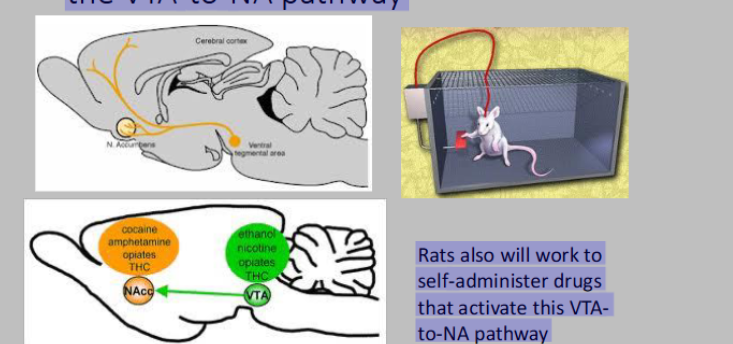
DA neurons in the VTA change their activity patterns during ____ learning
reward
A. VTA neural response to an unexpected juice reward
B. After learning, VTA neural response to the cue that predicts the impending juice
reward
C. When juice reward is predicted but not delivered, VTA neural activity is suppressed
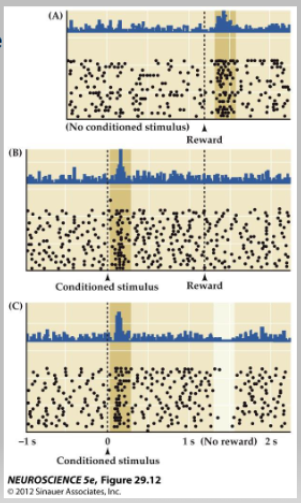
Virtually all ____-prone drugs including widely disparate ______ _____ drugs like morphine, cocaine, alcohol and marijuana, have been found to ____ brain
stimulation reward or ____ brain reward thresholds in these circuits
Virtually all abuse-prone drugs including widely disparate pharmacologically acting drugs like morphine, cocaine, alcohol and marijuana, have been found to enhance brain stimulation reward or lower brain reward thresholds in these circuits
All drugs of abuse increase dopamine release in the ____ _____
nucleus accumbens (NAc)
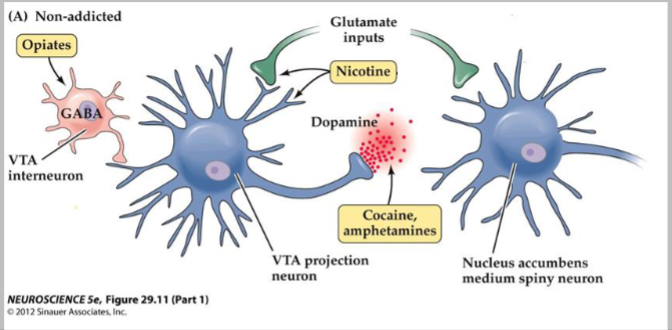
What are the effects of nicotine?
• binds to ACh receptors on VTA neurons causing depolarization
• increases glutamate release onto VTA neurons
• Both effects increase DA release from VTA neurons projecting to the NAc
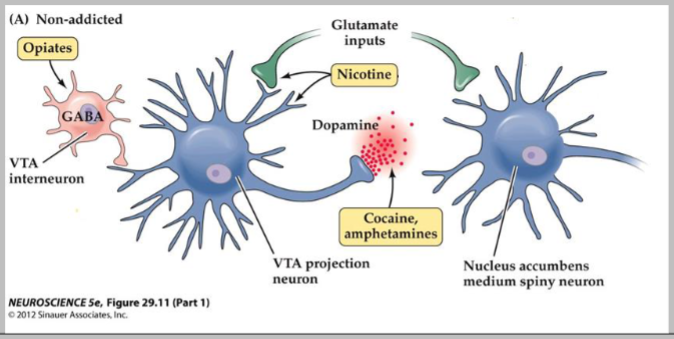
What are the effects of cocaine and amphetamine?
• Block DA reuptake into VTA axon terminals – increasing effect of DA in the NAc
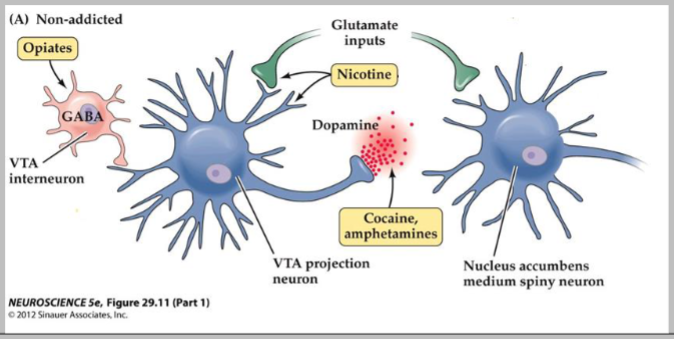
What are the effects of opiates
• bind to ___ receptors on the axon terminals of ____ ____
• Opiates are ____ – therefore decrease ____release
• This ____ ____neurons and....yep....increases ____ release in the ___
• bind to opioid receptors on the axon terminals of GABAergic interneurons
• Opiates are inhibitory – therefore decrease GABA release
• This disinhibits VTA neurons and....yep....increases dopamine release in the NAc
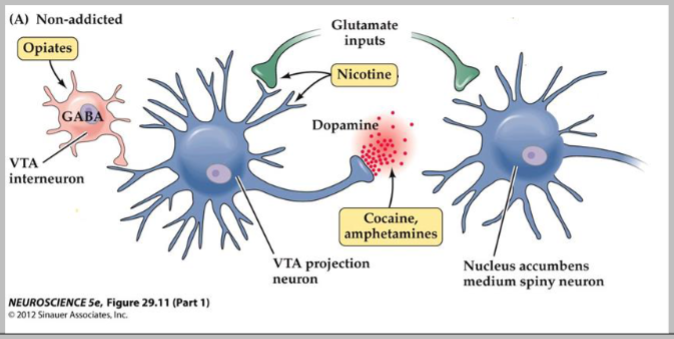
1 orgasm = how many cheeseburgers?
2 cheeseburgers
food produces less dopamine than sex
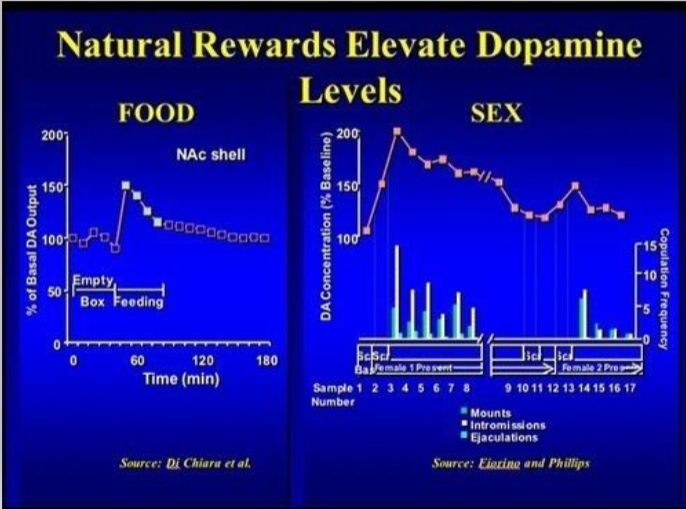
What do drugs do to the levels of dopamine?
Increase
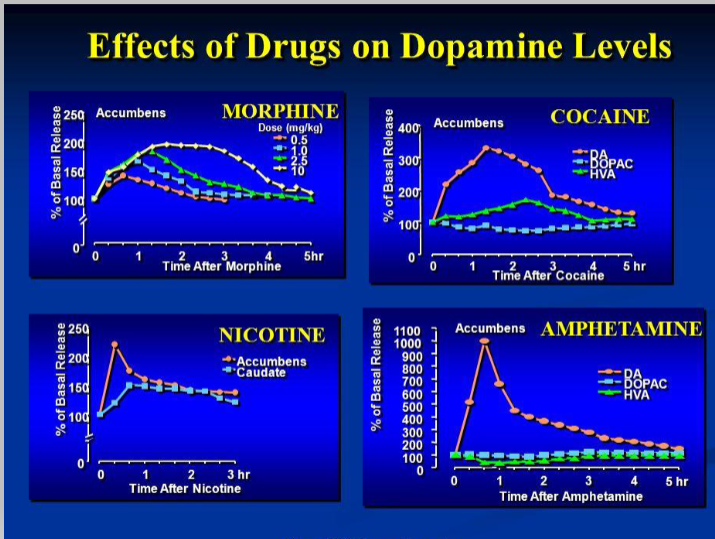
What is addiction?
• Corruption of the dopaminergic system extending from the ventral tegmental area (VTA)
• Addictive drugs “artificially” increase dopamine levels in situations that would normally have lower levels of dopamine
• Affects the perception/processing of reward
• Reinforce addictive behavior by increasing dopamine at the wrong time/circumstance
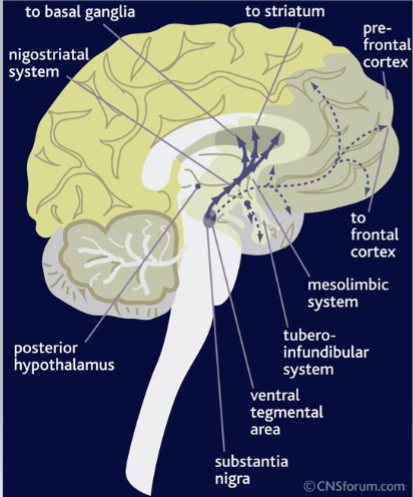
What is the relation between D2 receptors and Anhedonia?
see pic
As a result, addicted subjects don’t feel “normal” unless they have dopamine levels increased by their drug of choice
